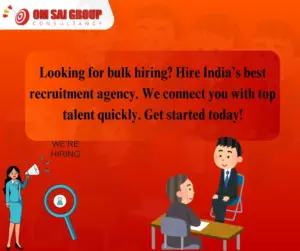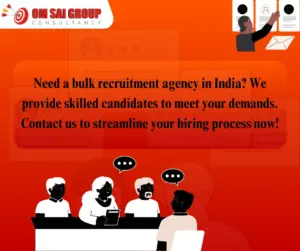India’s top recruitment agency for bulk hiring

Top Recruitment firm in India for mass hiring: The Innovation in High-volume talent acquisition Observation: India’s Need for Mass hiring Bulk Hiring is an outstanding challenge for corporations in the present world of business, with rapid velocity acceleration and a labor force that increasingly moves around. India’s top recruitment agency for bulk hiring No matter if it is a multinational that is opening a new location, or a high-flying startup that is increasing operations, the sheer volume of personnel made in a short period of time is always daunting. The intricate talent acquisition procedures are thus transformed into streamlined, effective, and goal-oriented tactics by India’s leading recruitment agency for bulk hiring. In the last few years, fresh graduates have been in increased demand by bulk hiring organizations. especially in the sectors of e-commerce, manufacturing, retail, healthcare, and information technology. Companies are always on the lookout for Indian bulk recruitment companies that offer pre-screened, qualified candidates who can hit the ground running. However, it is not easy to find the right recruitment partner because companies need to sort through a list of the top Indian recruitment consultants to find the one that best meets their specific hiring needs. Interest: The Need for Expert Agencies and the Problem of En Mass Recruiting Hiring in volume is something conventional hiring can barely handle. It’s tedious, time-consuming, and a hotbed of mistakes. Here’s why employers struggle: Access to diverse pool is limited by reliance on an employer’s internal HR department. . Unreliable candidate quality: thousands of resumes have to be manually screened, which is a basis for hiring decisions that are not quite good fits. . Long turn-around times: business scalability is hampered by slow hiring procedures. . High attrition rates: unstable workforces are the result of bad hiring practices. The problem can be addressed only by the best recruitment firms of India that are specialized in bulk hiring. With a vast network, technology-enabled tests, and data-driven hiring, these firms help companies speed up the hiring process while retaining the best fit for the available positions. Desire: Why Bulk Hiring Is the Best? In addition to offering high-volume hiring solutions, the top recruitment companies in India prioritize quality, retention, and seamless onboarding. Prominent organizations like ABC Job Placement Consultants have effectively placed thousands of workers for sectors like banking and logistics. However, what distinguishes them? . Mass Outreach & Industry Expertise: These organizations use AI-powered analytics and in-depth industry knowledge to find and draw in the top talent. . Pre-screened talent pool: Their sizable database of applicants who are prepared for hire, which is intended to guarantee quick turnaround. . The agencies oversee every phase of the hiring process, from sourcing and screening to onboarding and training. . A streamlined recruitment process is made possible by their systematic processes, which result in significant hiring cost and operational overhead savings when hiring in bulk. . These agencies can meet corporate needs by hiring people for a single project or for a continuous workforce. With an emphasis on cultural fit and local recruiting compliance, this enables Chennai bulk hiring providers to provide region-specific talent acquisition for businesses operating in South India. Now is the time to move forward with hiring excellence. Now is the perfect time for an organization that requires the best 10 recruitment companies in India for mass hiring. You can reach a highly skilled workforce, reduce the time taken to hire, and improve retention by partnering with the right recruitment agency. With the assistance of foreign career opportunities for Indian specialists, leading recruitment companies also focus on international talent hunting for companies that need the finest Indian consultants to be hired overseas. Large-scale hiring is no longer that scary. Experience an even smarter, faster, and better hiring process. Contact the leading recruitment firm now. Know about the top ten recruitment consultancy firms in India and proceed strategically towards manpower excellence. Ensure the recruitment partner suits the best recruitment solutions for the people you need!









